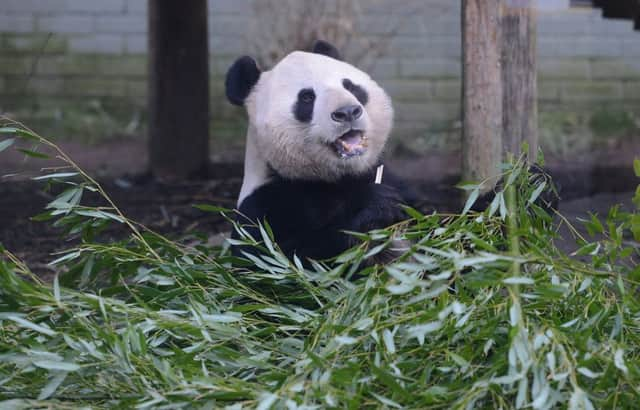How laid back pandas survive on bamboo diet


A 90-kilo (14-stone) panda expends less than half the energy of a human with the same weight, research shows.
The panda’s energy-saving metabolism allows it to live on a diet consisting almost entirely of low-calorie bamboo.
Advertisement
Hide AdAdvertisement
Hide AdJust to survive, one of the animals has to consume up to 50lb of bamboo each day.
Pandas used to be meat eaters but turned vegetarian and because their guts remain designed for digesting meat, the bears have to eat vast quantities of bamboo to survive.
Professor John Speakman, from the University of Aberdeen and Chinese Academy of Sciences, said: “Pandas save a lot of energy by being frugal with the energy they spend on physical activity.
“Using GPS loggers attached to pandas, we discovered that they rest for more than half of the day and, on average, only travel at 20 metres an hour.
“However, it is not only their low activity that contributes to their low metabolism; the metabolic rate of an active panda is still lower than a completely stationary human.
“We found that their low metabolism is correlated with very low levels of their thyroid hormones, which was linked to a genetic mutation that is unique to the panda.”
A big problem with having such a low metabolic rate is keeping warm.
Pandas have thick fur to trap their body heat, but their surface temperature is much lower than that of other black and white animals such as zebras and dalmatian dogs, said the researchers.
The findings are reported in the journal Science.
Advertisement
Hide AdAdvertisement
Hide AdResearchers at the Chinese Academy of Sciences (CAS), Beijing Zoo and Aberdeen University measured the metabolic rates of pandas living both in captivity and in the wild.
Professor Speakman added: “It has been a real pleasure to be involved in this international collaboration which has revealed some amazing insights into how the panda manages to survive on its bamboo diet.
“The combination of behavioural and physiological responses that enable this low metabolic rate is fascinating.”
The study was funded by the National Science Foundation of China and the Chinese Academy of Sciences.
The only two giant pandas in the UK are at Edinburgh Zoo. Yang Guang (Sunshine) and Tian Tian (Sweetie) arrived from China in 2011 on lease from China’s Bifengxia Breeding Centre at a cost of $1 million a year.
The pandas, which quickly became the zoo’s main attractions, live in a custom-built enclosure. Despite fevered speculation each year since their arrival, the male and female panda have yet to produce a cub.